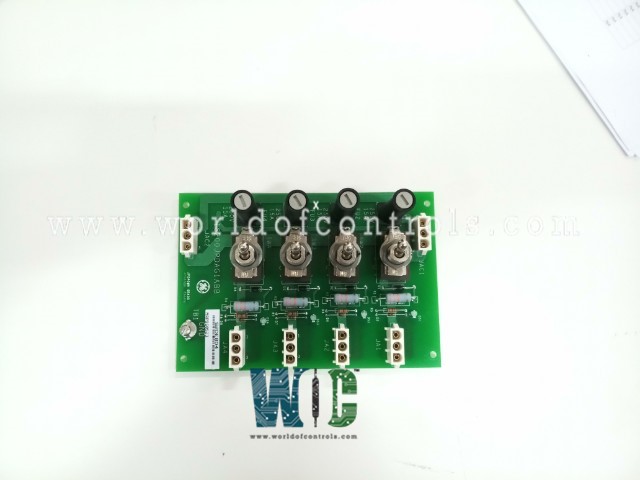SPECIFICATIONS
Part No.: IS200JPDAG1AAA
Manufacturer: General Electric
Country of Manufacture: United States of America (USA)
Inputs: One 3-pin connection
Outputs: Five 3-pin connections
One 3-pin connection for output power to another JPDA board
Output fuses: Four fuses
Temperature: -30 to +65oC
Board Size: 15.875 cm high x 10.795 cm wide
Mounting: DIN-rail, card carrier mounting
Processor: Texas Instruments TMS320C32
Product Type: Local AC Power Distribution Board
Availability: In Stock
Series: Mark VIe
Functional Description
IS200JPDAG1AAA is a Local AC Power Distribution Board developed by GE. It is a part of Mark VIe control system. The board stands as a pivotal component within the broader framework of control and I/O functions, particularly catering to those demanding AC power. Its multifaceted role encompasses not only the distribution of AC power but also includes crucial features such as power isolation and branch circuit protection. This versatile board finds its applications in a spectrum of scenarios, ranging from AC relay and solenoid control power to ignition transformer excitation and contact wetting. Let's delve into the intricacies of the board to comprehend its functions and significance in enhancing the reliability and safety of diverse control systems.
AC Power Distribution
- Customized Power Delivery: It takes charge of delivering AC power precisely where it's needed. Its design accommodates various control and I/O functions that rely on AC power, ensuring tailored power distribution based on specific requirements.
- Dedicated Outputs: Each output channel on the JPDA board is meticulously crafted to serve a specific purpose. Whether it's facilitating AC relay operations, energizing solenoids, providing ignition transformer excitation, or ensuring contact wetting, it offers dedicated outputs for diverse applications.
Features
- Switch Mechanism: Recognizing the importance of control over power supply, the board incorporates a switch for power isolation on each output channel. This feature empowers operators to selectively isolate power to individual functions, facilitating maintenance, troubleshooting, or modifications without affecting the entire system.
- Fuse Safeguards: Each output channel is equipped with a fuse, serving as a proactive safeguard against potential overcurrent conditions. The inclusion of fuses ensures that in the event of a fault or surge, only the affected branch circuit is impacted, minimizing the risk of widespread disruptions and damage.
- Status Indication: To enhance user awareness, the board integrates a LED for each output, serving as a visual indicator of the presence of output voltage. This status indication feature is instrumental in quick diagnostics, providing operators with immediate insights into the operational status of each connected function.
Installation
- Mounting: Designed to be mounted in a plastic holder, which, in turn, fits onto a vertical DIN-rail. The DIN-rail provides a standardized and secure mounting platform, ensuring the JPDA board is stably positioned within the control system. Carefully affix the board to the plastic holder, aligning it with the DIN-rail for a snug fit.
- Connecting Power Cables: Both power input and output cables are equipped with three-position Mate-N-Lok connectors. Ensure a secure and proper connection by aligning the connectors correctly. For specific cable destinations, operators are advised to consult the circuit diagram provided with the system documentation.
- Ground Connection at TB1: TB1 serves as the chassis ground connection point. It is imperative during the installation process to establish a robust ground connection by providing a ground lead from TB1 to the system Protective Earth (PE). This step is crucial for creating a reliable ground path, particularly for the metal switch bodies integrated into the board.
- Ensuring Ground Path for Switch Bodies: The creation of a ground lead from TB1 to the system PE is specifically emphasized to establish a comprehensive ground path for the metal switch bodies present on the board. This measure ensures effective grounding, mitigating the risk of electrical interference and enhancing the safety of the entire system.
- Verifying Circuit Connections: Before completing the installation, operators should conduct a thorough verification of the circuit connections. Cross-reference the actual connections with the circuit diagram to confirm that each cable is appropriately connected to its designated destination. Any discrepancies should be addressed promptly to prevent operational issues.
- Functional Testing: Once the board is securely mounted, cables properly connected, and the ground path established, conduct a functional test. Power up the system and monitor for proper operation. Verify that the status indicators, including the lamps for voltage presence, are functioning as expected.
The WOC team is always available to help you with your Mark VIe requirements. For more information, please contact WOC.
Frequently Asked Questions
What is IS200JPDAG1AAA?
It is a Local AC Power Distribution Board developed by GE under the Mark VIe series.
Are there limitations on the fuse ratings that can be used with the board?
Yes, there are limitations. Fuses above 15A should not be used with the board. It is crucial to adhere to this specification to maintain the integrity and safety of the board.
Can I configure with alternate fuse ratings?
Yes, if alternate fuse ratings are desired, the configuration of the board can be adjusted accordingly. This involves the insertion of the proper fuse in each branch circuit to align with the chosen ratings.
Why is there a restriction on using fuses above 15A?
The restriction on using fuses above 15A is likely based on the design and safety specifications. Exceeding this limit could compromise the board's functionality and pose potential risks to the overall system.
